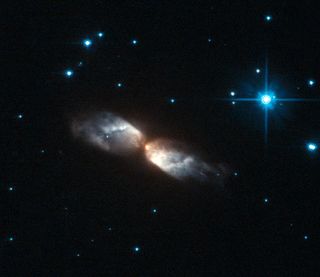Hubble's Striking Photo of Dying Star Heralds Birth of Nebula

The Hubble Space Telescope has takena striking photo of astar in its death throes.
The dying star is throwing off hugeclouds of gas and dust,preparing to enter the planetary nebula stage of its life. But contrarytotheir name, planetary nebulas have nothing to do with planets; the nameinsteadrefers to their superficial resemblance to giant planets when seenthrough earlytelescopes. [New photo of dying star]
Planetarynebulas form when stars like this one ? which is called IRAS20068+4051 ?exhaust their hydrogen fuel. The stars' outer layers expand and cool,creatinga huge, surrounding envelope of dust and gas.
IRAS 20068+4051, which is found inthe constellation Cygnus,hasn't yet become a full-blown planetary nebula, researchers said. It'sstill inthe short-lived protoplanetary nebula phase, and could thus giveastronomerskey insights into how planetary nebulas form and evolve.
Powerful stellar winds have shapedthe star's envelope ?which was originally spherical ? into the intricate shape seen in thenew image.As the star continues to evolve, it will eventually become hot enoughto makethis gas cloud glow, creating a spectacular planetary nebula,researchers said.
Planetary nebulas emit a broadspectrum of radiation,including visible light, making them greattargets for both amateur and professional astronomers.
However, protoplanetary nebulas,which often appear smallerand are viewed best in infrared light, are much trickier to observe,particularly since water vapor in the Earth?s atmosphere absorbsinfraredradiation at most wavelengths. But, Hubble'ssharp vision and unobstructed vantage point in space make itpossible tocapture good images of these peculiar cosmic objects.
Get the Space.com Newsletter
Breaking space news, the latest updates on rocket launches, skywatching events and more!
This picture was created from imagestaken through yellow(colored blue in the photo) and near-infrared (colored red) filtersusing theHigh Resolution Channel of Hubble?s Advanced Camera for Surveys.
- Images:20 Years of the Hubble Space Telescope
- Gallery:Spectacular Nebula Photos
- Photoof Dying Stars Looks Like Cosmic Jellyfish With Rings
Join our Space Forums to keep talking space on the latest missions, night sky and more! And if you have a news tip, correction or comment, let us know at: community@space.com.

Space.com is the premier source of space exploration, innovation and astronomy news, chronicling (and celebrating) humanity's ongoing expansion across the final frontier. Originally founded in 1999, Space.com is, and always has been, the passion of writers and editors who are space fans and also trained journalists. Our current news team consists of Editor-in-Chief Tariq Malik; Editor Hanneke Weitering, Senior Space Writer Mike Wall; Senior Writer Meghan Bartels; Senior Writer Chelsea Gohd, Senior Writer Tereza Pultarova and Staff Writer Alexander Cox, focusing on e-commerce. Senior Producer Steve Spaleta oversees our space videos, with Diana Whitcroft as our Social Media Editor.
